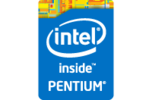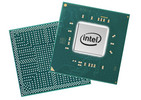Intel Pentium Gold 4415U vs Intel Celeron N4020
Intel Pentium Gold 4415U
► remove from comparison
The Intel Pentium 4415U is an ULV (ultra low voltage) dual-core SoC based on the Kaby-Lake architecture and has been launched in the first quarter of 2017. The CPU can be found in ultrabooks as well as normal notebooks. In addition to two CPU cores with Hyper-Threading clocked at 2.3 GHz (no Turbo Boost), the chip also integrates an HD Graphics 610 GPU and a dual-channel DDR4-2133/DDR3L-1600 memory controller. The SoC is manufactured using a 14 nm process with FinFET transistors.
Architecture
Intel basically uses the same micro architecture compared to Skylake, so the per-MHz performance does not differ. The manufacturer only reworked the Speed Shift technology for faster dynamic adjustments of voltages and clocks, and the improved 14nm process allows much higher frequencies combined with better efficiency than before.
Performance
Compared to the more expensive Core i3-7100U, the 4415U offers a similar CPU performance (2.3 versus 2.4 GHz) and less level 3 cache but a slower integrated graphics card. Still, the CPU has sufficient power for office and multimedia purposes as well as somewhat more demanding applications.
Graphics
The integrated graphics unit called HD Graphics 610 (similar to the HD Graphics 510) represents the "GT1" version of the Kaby Lake GPU (Intel Gen. 9). Its 12 Execution Units, also called EUs, are clocked at 300 - 950 MHz and offer a performance somewhat below the older HD Graphics 4400. Only a few games of 2015 can be played smoothly in lowest settings.
Power Consumption
Specified at a TDP of 15 W (including CPU, GPU and memory controller), the CPU is best suited for small notebooks and ultrabooks (11-inches and above). Optionally, the TDP can be lowered to 10 watts (cTDP down), reducing both heat dissipation and performance and allowing even more compact designs.
Intel Celeron N4020
► remove from comparison
The Intel Celeron N4020 is a slow dual-core processor (SoC) of the Gemini Lake refresh product family; as such, it is designed for use in laptops and mini-PCs of the most affordable flavor. The Celeron was launched in Q4 2019. Its CPU cores run at 1.1 GHz to 2.8 GHz, the latter being a moderate 200 MHz upgrade over the preceding N4000 chip. Other key specs include a DDR4/LPDDR4 memory controller (up to 2,400 MHz and up to 8 GB, with independent reports claiming as much as 32 GB will work just fine) and an integrated UHD 600 graphics adapter.
Architecture & Features
Just like Apollo Lake family products, the ever-popular N3350 included, the N4020 is manufactured on a really old, as of late 2023, 14 nm process. What makes the newer Celerons different are the slightly improved processor cores with double the L2 cache and also, somewhat counterintuitively, a reduction in physical size.
The Goldmont Plus microarchitecture is not much different from what was used in Gemini Lake processors like the N4000. A relatively large 4 MB L2 cache features prominently on the rather short list of N4020's strong sides, allowing for a marginal increase in performance-per-MHz figures compared to processors of previous generations. Still, Gemini Lake refresh processors are a clear step down from Core i3/i5/i7/i9 series processors, both in performance and in features.
The N4020 has six PCI-Express 2.0 lanes at its disposal. While very few N4020-based SBCs, nettops and laptops feature an NVMe M.2 slot, you can use an NVMe SSD as a boot drive with this processor (read/write rates will be limited to 2 GB/s, though). Furthermore, partial Wi-Fi 5 support is built into the CPU. The Celeron also supports up to eight USB 3.0 ports and two SATA III storage devices.
Please note this is not a user-replaceable CPU. They solder it straight to the motherboard for good (BGA1090 socket interface).
Performance
While slightly faster than the outgoing Celeron N4000, the average N4020 in our extensive database only just manages to match the N6211, as far as multi-thread performance is concerned. These three chips deliver multi-thread CB R15, CB R20 and CB R23 scores that are so low, they lag behind a single-thread score of any half-decent CPU such as an i5-1135G7. In other words, these Celeron N chips are good enough for basic tasks only such as word processing and Web browsing with two or three tabs open at a time.
The Celeron N4120, a quad-core chip with a similar name, has little trouble leaving the N4020 behind in most workloads - which is not to say it is a fast CPU.
Jacking the long-term power limit value up to something like 9 W will help improve system responsiveness noticeably.
Graphics
The UHD Graphics 600 is based on Intel's Generation 9 architecture, much like the HD Graphics 520 or the UHD Graphics 615 or other widespread Intel iGPUs found in Core i3/i5/i7/i9 processors of generations six to ten.
Just like the HD Graphics 500, the UHD Graphics 600 is DX12 compatible. The iGPU's 12 EUs can run at up to 650 MHz. The Iris Plus G7 iGPU that certain 10th Gen Ice Lake processors have packs 64 EUs, for reference. As a low-end solution, UHD Graphics 600 will let you play some seriously old titles, but that's about as far as its talents go.
Perhaps more importantly, this graphics solution can drive up to 3 monitors with resolutions as high as 4096x2160@60. Furthermore, it will have no trouble HW-decoding AVC, HEVC and VP9-encoded videos. The newer AV1 codec will be decoded via software, with the limited CPU horsepower imposing a limit on video resolutions that can be played back without stuttering. 1080p60 videos are out of reach while 720p25 videos run fine, to give you an example.
Power consumption
The low 6 W TDP (also known as the long-term Power Limit) makes it easy for laptop makers to ditch the fan. Performance sustainability will be poor unless the long-term Power Limit is set to a value higher than the default 6 W and a fan is available to aid in heat dissipation.
The Celeron N4020 is built with one of the old 14 nm Intel processes for poor, as of mid 2023, energy efficiency.
| Model | Intel Pentium Gold 4415U | Intel Celeron N4020 | ||||||||||||||||||||||||||||||||||||||||||||||||||||||||||||||||||||||||||||||||||||||||||||||||||||||||||||||||||||||||||||||||||||||||||||||||||||||||||||||||||||||||||||||||||||||||||||||||
| Series | Intel Kaby Lake | Intel Gemini Lake | ||||||||||||||||||||||||||||||||||||||||||||||||||||||||||||||||||||||||||||||||||||||||||||||||||||||||||||||||||||||||||||||||||||||||||||||||||||||||||||||||||||||||||||||||||||||||||||||||
| Codename | Kaby Lake | Gemini Lake refresh | ||||||||||||||||||||||||||||||||||||||||||||||||||||||||||||||||||||||||||||||||||||||||||||||||||||||||||||||||||||||||||||||||||||||||||||||||||||||||||||||||||||||||||||||||||||||||||||||||
| Series: Gemini Lake Gemini Lake refresh |
|
| ||||||||||||||||||||||||||||||||||||||||||||||||||||||||||||||||||||||||||||||||||||||||||||||||||||||||||||||||||||||||||||||||||||||||||||||||||||||||||||||||||||||||||||||||||||||||||||||||
| Clock | 2300 MHz | 1100 - 2800 MHz | ||||||||||||||||||||||||||||||||||||||||||||||||||||||||||||||||||||||||||||||||||||||||||||||||||||||||||||||||||||||||||||||||||||||||||||||||||||||||||||||||||||||||||||||||||||||||||||||||
| L1 Cache | 128 KB | |||||||||||||||||||||||||||||||||||||||||||||||||||||||||||||||||||||||||||||||||||||||||||||||||||||||||||||||||||||||||||||||||||||||||||||||||||||||||||||||||||||||||||||||||||||||||||||||||
| L2 Cache | 512 KB | 4 MB | ||||||||||||||||||||||||||||||||||||||||||||||||||||||||||||||||||||||||||||||||||||||||||||||||||||||||||||||||||||||||||||||||||||||||||||||||||||||||||||||||||||||||||||||||||||||||||||||||
| L3 Cache | 2 MB | |||||||||||||||||||||||||||||||||||||||||||||||||||||||||||||||||||||||||||||||||||||||||||||||||||||||||||||||||||||||||||||||||||||||||||||||||||||||||||||||||||||||||||||||||||||||||||||||||
| Cores / Threads | 2 / 4 | 2 / 2 | ||||||||||||||||||||||||||||||||||||||||||||||||||||||||||||||||||||||||||||||||||||||||||||||||||||||||||||||||||||||||||||||||||||||||||||||||||||||||||||||||||||||||||||||||||||||||||||||||
| TDP | 15 Watt | 6 Watt | ||||||||||||||||||||||||||||||||||||||||||||||||||||||||||||||||||||||||||||||||||||||||||||||||||||||||||||||||||||||||||||||||||||||||||||||||||||||||||||||||||||||||||||||||||||||||||||||||
| Technology | 14 nm | 14 nm | ||||||||||||||||||||||||||||||||||||||||||||||||||||||||||||||||||||||||||||||||||||||||||||||||||||||||||||||||||||||||||||||||||||||||||||||||||||||||||||||||||||||||||||||||||||||||||||||||
| max. Temp. | 100 °C | |||||||||||||||||||||||||||||||||||||||||||||||||||||||||||||||||||||||||||||||||||||||||||||||||||||||||||||||||||||||||||||||||||||||||||||||||||||||||||||||||||||||||||||||||||||||||||||||||
| Socket | BGA | BGA1090 | ||||||||||||||||||||||||||||||||||||||||||||||||||||||||||||||||||||||||||||||||||||||||||||||||||||||||||||||||||||||||||||||||||||||||||||||||||||||||||||||||||||||||||||||||||||||||||||||||
| Features | Dual-Channel LPDDR3-1866/DDR4-2133 Memory Controller, HyperThreading, AVX, AVX2, Quick Sync, Virtualization, AES-NI | DDR4-2400/LPDDR4-2400 RAM, PCIe 2, MMX, SSE, SSE2, SSE3, SSSE3, SSE4.1, SSE4.2, VMX, SMEP, SMAP, MPX, EIST, TM1, TM2, Turbo, AES-NI, RDRAND, RDSEED, SHA, SGX | ||||||||||||||||||||||||||||||||||||||||||||||||||||||||||||||||||||||||||||||||||||||||||||||||||||||||||||||||||||||||||||||||||||||||||||||||||||||||||||||||||||||||||||||||||||||||||||||||
| iGPU | Intel HD Graphics 610 (300 - 950 MHz) | Intel UHD Graphics 600 (200 - 650 MHz) | ||||||||||||||||||||||||||||||||||||||||||||||||||||||||||||||||||||||||||||||||||||||||||||||||||||||||||||||||||||||||||||||||||||||||||||||||||||||||||||||||||||||||||||||||||||||||||||||||
| Architecture | x86 | x86 | ||||||||||||||||||||||||||||||||||||||||||||||||||||||||||||||||||||||||||||||||||||||||||||||||||||||||||||||||||||||||||||||||||||||||||||||||||||||||||||||||||||||||||||||||||||||||||||||||
| $161 U.S. | ||||||||||||||||||||||||||||||||||||||||||||||||||||||||||||||||||||||||||||||||||||||||||||||||||||||||||||||||||||||||||||||||||||||||||||||||||||||||||||||||||||||||||||||||||||||||||||||||||
| Announced | ||||||||||||||||||||||||||||||||||||||||||||||||||||||||||||||||||||||||||||||||||||||||||||||||||||||||||||||||||||||||||||||||||||||||||||||||||||||||||||||||||||||||||||||||||||||||||||||||||
| Manufacturer | ark.intel.com | ark.intel.com | ||||||||||||||||||||||||||||||||||||||||||||||||||||||||||||||||||||||||||||||||||||||||||||||||||||||||||||||||||||||||||||||||||||||||||||||||||||||||||||||||||||||||||||||||||||||||||||||||
| TDP Turbo PL2 | 15 Watt |


 Deutsch
Deutsch English
English Español
Español Français
Français Italiano
Italiano Nederlands
Nederlands Polski
Polski Português
Português Русский
Русский Türkçe
Türkçe Svenska
Svenska Chinese
Chinese Magyar
Magyar